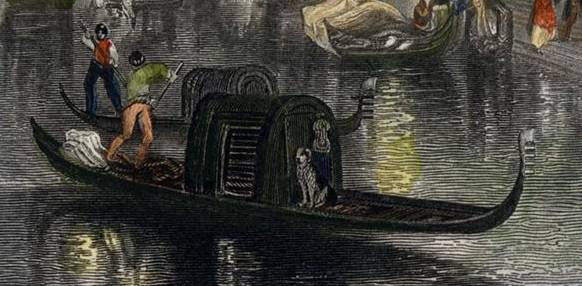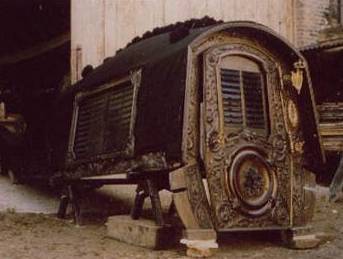 We’ve got Venetian blinds on most of the windows in our house. Depending on a given window’s age, you open and close its blinds using either a traditional drawstring-and-pulley arrangement, or one of those long rods (the preferred term, apparently, is wands) which hang down the (usually) left side. Twist the wand in one direction, the blinds open; in the other direction, they close.
We’ve got Venetian blinds on most of the windows in our house. Depending on a given window’s age, you open and close its blinds using either a traditional drawstring-and-pulley arrangement, or one of those long rods (the preferred term, apparently, is wands) which hang down the (usually) left side. Twist the wand in one direction, the blinds open; in the other direction, they close.
I have noticed that The Missus and I have different preferences, conscious or otherwise, about closed blinds — preferences in the way they slant: down into the house, or down to the outside. Actually, my preferences differ from room to room, even window to window. The Missus, for her part, seems to always choose the “slanting down and in” option. If you survey the house’s windows by walking from room to room, you’ll see some closed blinds tilting up, and some tilting down. This means that in order to open them, the direction in which to twist the wand depends on who closed them. (You are following this, right?)
I’d noticed that preference a long time ago. As it happens, I’ve got conscious reasons for my preference — can’t speak for The Missus — but the preference isn’t a strong one. (Mostly, I don’t know if my reasons actually make sense or are just the product of an easily distracted imagination.)
Until the last week or so, though, I’d never wondered about the wands. But there I was in front of a window, my left hand on the wand, and I was turning it to open (or close) the blinds, and I suddenly, well, noticed I was doing it. And I said to myself: Huh. How’d I know to do that?
I’d never wondered about The Opening (or Closing) Twist: how do we know which way to turn the wand? Is this a special form of whatzit, muscle memory? (I don’t think so, because there’s a little cognitive switch which has to flip before the muscles take over.) It’s gotta be a learned behavior — can’t imagine our ancestors ever needing the particular skill, right? — and the consequences of getting it wrong aren’t great in any case. (Get it backwards? Oh. Just twist in the other direction.) What interested me at the moment was that I’d surely closed these things thousands of times… and never had to stop and consider — like, “Hmm, which way should I twist this thing for the desired effect?”
Look at the image above. I bet if I asked you to close those blinds so they slant down and in, you’d know which way to twist the wand, wouldn’t you? How did you know to do that?
________________
Aside: We fairly recently got new “French doors” to the back deck. Their glass (like the glass on the regular windows) is double-paned. However, on the French doors, the panes are separated not by a tiny bit of insulating dead air, but by, oh, maybe a full centimeter or two. Sandwiched between these panes are built-in Venetian blinds, which open and close using a sliding switch at the top of the door: push it to the left to tilt the blinds in one direction, to the right otherwise. (You raise and lower the blinds with a sliding switch on the right side of the pane.) This sliding-switch thing still trips me up every now and then; I always have to stop to think which way to push it to open/close the blinds in the direction I want.



Froog says
Ha! I don’t know if it’s my limited experience with the ‘wand’ blind openers or a congenital lack of ept, but I invariably being by twisting the wrong way.
But I guess this only happens when I’m visiting the States. Venetian blinds aren’t all that common in Britain, and I can’t recall ever encountering the wand widget there.
John says
Interesting that they’re not common in Britain… the first patents which Wikipedia reports (not that that’s the ultimate authority) were in 1760s-era England.
Having thought about it some more, I’m ready to try explaining this so that one always gets the wand-twisting right:
Assume the wand hangs from the left side of the blind. Hold the lower tip out so that the wand is parallel to the ground, pointing to the left. Now imagine that the wand is a slat in the blind itself… and twist it accordingly, away from or towards you. After you do this a couple of times it should come naturally enough. (Famous last words!)
(And if the wand is on the right, by the way, follow the same instructions — just point it out to the right instead of the left.)
Froog says
Recatpcha says I ‘sent sleguab’. Indeed I did! Begin the being…
Oh, my poor tired brain!
s.o.m.e. one's brudder says
More important – what’s Venice got to do with any of it?
John says
I actually looked into the “Venetian” term while working on this post. The story’s murky, but in general form it seems to go something like this:
(1) Slatted blinds invented somewhere in the Far East — China or Japan — and brought thence to Persia (i.e., Turkey).
(2) The things were imported to Venice from Turkey. (At least one source maintained that they’re called “Turkish blinds” in Venice itself.)
(3) From Venice they spread to the rest of Europe — especially France — so that by the mid-18th century various patents were being issued for one form or the other, in England and elsewhere.
In Venice, they saw widespread use in the little cabins (called felzi — I think that’s the proper plural form for the singular felze) built into gondolas, for the protection of passengers from the elements. (Or for their privacy, I guess.) For instance, here’s a portion of an old painting/etching:

 …and over at the right is a photograph — maybe early 20th century? — of a felze before being mounted on its gondola.
…and over at the right is a photograph — maybe early 20th century? — of a felze before being mounted on its gondola.
Given that gondolas are such a big part of what people think of — maybe have always thought of — when they think of Venice, it’s not hard to imagine that the first mental association of the blinds with the city might have taken that route.
Well, you asked. :)